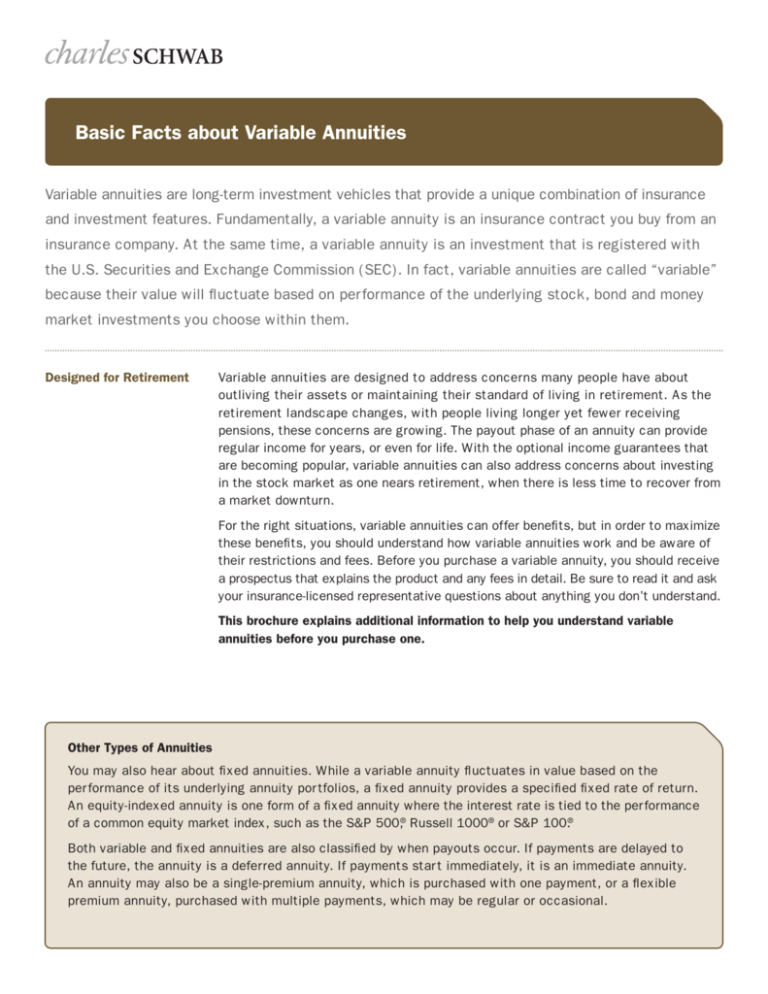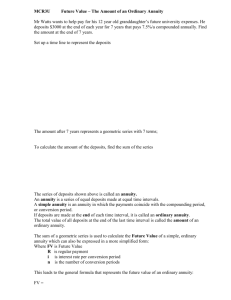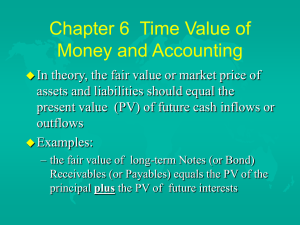
Basic Facts about Variable Annuities
Variable annuities are long-term investment vehicles that provide a unique combination of insurance
and investment features. Fundamentally, a variable annuity is an insurance contract you buy from an
insurance company. At the same time, a variable annuity is an investment that is registered with
the U.S. Securities and Exchange Commission (SEC). In fact, variable annuities are called “variable”
because their value will fluctuate based on performance of the underlying stock, bond and money
market investments you choose within them.
Designed for Retirement
Variable annuities are designed to address concerns many people have about
outliving their assets or maintaining their standard of living in retirement. As the
retirement landscape changes, with people living longer yet fewer receiving
pensions, these concerns are growing. The payout phase of an annuity can provide
regular income for years, or even for life. With the optional income guarantees that
are becoming popular, variable annuities can also address concerns about investing
in the stock market as one nears retirement, when there is less time to recover from
a market downturn.
For the right situations, variable annuities can offer benefits, but in order to maximize
these benefits, you should understand how variable annuities work and be aware of
their restrictions and fees. Before you purchase a variable annuity, you should receive
a prospectus that explains the product and any fees in detail. Be sure to read it and ask
your insurance-licensed representative questions about anything you don’t understand.
This brochure explains additional information to help you understand variable
annuities before you purchase one.
Other Types of Annuities
You may also hear about fixed annuities. While a variable annuity fluctuates in value based on the
per formance of its underlying annuity portfolios, a fixed annuity provides a specified fixed rate of return.
An equity-indexed annuity is one form of a fixed annuity where the interest rate is tied to the performance
of a common equity market index, such as the S&P 500,® Russell 1000® or S&P 100.®
Both variable and fixed annuities are also classified by when payouts occur. If payments are delayed to
the future, the annuity is a deferred annuity. If payments start immediately, it is an immediate annuity.
An annuity may also be a single-premium annuity, which is purchased with one payment, or a flexible
premium annuity, purchased with multiple payments, which may be regular or occasional.
Variable Annuities: From
Investment to Income
Variable annuities have two phases.
•Accumulation phase, during which you can build assets for retirement through
your selection of annuity por tfolios.
•Payout phase, during which you receive payments in either a lump sum, periodic
withdrawals or through the process of “annuitization,” which converts your
assets into an ongoing income stream. Under most contracts, this income stream
can be set up for a defined period of time or to last your lifetime.
Purchasing an Annuity
All states have laws that give you a set number of days to look at an annuity after
you buy it. Called the “free look,” this period allows you to change your mind. If you
decide during the free look period that you don’t want the annuity, you can return it
and get your money back. Your contract and the annuity prospectus will describe
this free look period.
Variable Annuity Features
Investment options: When you purchase a variable annuity, you choose from among a
selection of underlying annuity portfolios and possibly fixed income choices available
in the contract. These annuity portfolios are not available directly to the public;
rather they are available only within variable annuity contracts or other products
typically issued by an insurance company. As with publicly available mutual funds,
annuity portfolios have their own distinctive investment objectives and policies, and
typically offer exposure to stock or bond market returns.
Another thing to note is that a variable annuity contract holder does not invest
directly into these annuity portfolios (as you would do with a publicly available mutual
fund). Annuity contract holders invest in subaccounts available in the variable
annuity, which in turn pool the assets and invest in the underlying portfolios.
The annuity portfolios generally cover many asset classes and investment strategies:
equity, fixed income, balanced and money market funds, as well as value, growth, core
and other strategies. Many variable annuities offer asset allocation programs that allow
for a mix of asset classes according to your investment objectives, risk tolerance
and financial situation. In most contracts, you may transfer in and out of variable
investment options. As with any investment, there is potential for loss of principal.
Death benefits: With an annuity, you name one or more beneficiaries. A death
benefit is the sum your beneficiaries will receive when you die. Depending on the
contract, the benefit can provide your beneficiaries a guaranteed minimum upon your
death. The most basic death benefit is the “return of account value,” where your
beneficiaries receive the current contract value. “Return of premium,” or an amount
equal to everything you’ve paid for the annuity, minus withdrawals, is another
common death benefit. Another type pays the highest account value on any
anniversary of the date the annuity was purchased. In any event, the death benefit
proceeds bypass probate.
If you have taken withdrawals from the annuity, the death benefit will be reduced
accordingly. If your spouse is the beneficiary of the annuity, some contracts allow your
spouse to become the new owner of the contract while still receiving a death benefit.
Riders: Some annuities offer optional features—called riders—that provide additional
benefits for additional cost. For example, some riders protect against market,
inflation or longevity risk. A rider may also be an enhanced death benefit or a benefit
to allow for continued income for your spouse if you die.
Living benefits: Although annuities are investments and there is a risk of losing
money, some annuities, for additional cost, offer optional riders called “guaranteed
living benefits” that protect against loss or help address concerns about outliving
savings. Not all contracts offer living benefits, but they are becoming more common.
One type of living benefit that is becoming widespread is a guaranteed lifetime
withdrawal benefit (GLWB). A GLWB offers a guaranteed income stream for life while
allowing full access to your account value. These guarantees can provide you with the
peace of mind that no matter how long you live and no matter what direction the
market takes, you will receive guaranteed income for life. It is important, however,
that you understand any restrictions or fees before you purchase the GLWB and that
you feel comfortable with its terms and conditions.
Tax treatment: Annuity earnings are tax deferred during the accumulation phase,
which means you do not pay taxes on any earnings each year; you pay taxes on
earnings only when you withdraw your money. Any payouts are taxed as regular
ordinary income and you may be subject to a 10 percent penalty if you take them
before age 591/2. Another feature of most variable annuities is that they do not require
a minimum withdrawal at age 701/2 as do IRAs, 401(k)s and other qualified plans.
Costs and Considerations
Variable annuities are not all the same. Be sure you understand the costs and other
considerations associated with any variable annuity.
Fees
The fees on your variable annuity are typically assessed as a percentage of your
variable annuity account value. These fees can vary widely. Also, note that not all
variable annuities charge all these fees. The following are some typical fees you may
see in a variable annuity.
•Mortality and expense risk charge (M&E): This charge covers the insurer’s expense for
some of the key insurance guarantees of the contract such as the standard death
benefit, or for annuitization—the annuity payout option that can provide guaranteed
income for life.
•Administrative charges: Some contracts assess these charges to compensate the
insurance company for administrative costs associated with the contract, such as
preparing the prospectus, annual report, and legal and accounting expenses.
•Underlying fund expenses: These cover the management of the underlying annuity
portfolios in which you’ve allocated your assets.
•Rider fees: These fees compensate the insurance company for any optional features
and guarantees beyond the standard annuity contract. You only pay rider fees for the
riders you’ve selected. Riders might include stepped-up death benefits, GLWBs and
other living benefits, or principal protection for your spouse if you die, to name a few.
Other Considerations
Surrender charges: Be sure you understand what’s involved if you want to take
money out of your annuity. Because variable annuities are designed to be long-term
investments, if you withdraw money before a certain point in the contract, you may
incur a surrender charge, also known as contingent deferred sales charge (CDSC),
that could affect the value of your contract. You can find information about any
surrender charges spelled out in the annuity prospectus. Not all variable annuities,
including those at Schwab, impose surrender charges.
Load or no-load: With a no-load variable annuity, you do not pay an upfront commission
when buying the annuity, nor would you pay any surrender charges if you withdraw your
money early from the contract. Variable annuities at Schwab are no-load.
Market risk: The underlying annuity portfolios (and their corresponding subaccounts)
are subject to market risk and are not insured by the Federal Deposit Insurance
Corporation, the Federal Reserve Board or any other government agency, nor are
they a deposit of or guaranteed by any bank affiliate. The amount you invest may be
more or less than the amount that is available at the time of withdrawal.
Qualified retirement plans: Annuities may be purchased through regular contributions
to a 401(k), IRA or other retirement account. These accounts, however, already
provide tax-deferral; a variable annuity does not provide any additional tax benefit.
There may be additional benefits (such as a living benefit) that would warrant your
consideration of a variable annuity in your retirement account, but you should
carefully evaluate these benefits and their costs before you purchase.
The insurance component: While variable annuities are investment products
registered with the SEC, they are also insurance products. The insurance company
issuing the annuity supports the guarantees, such as any death and living benefits.
To support these guarantees, the insurer must set aside capital and reserves to
cover these obligations.
The guarantees are only as good as the insurance company backing them. It is
important to know the insurance company’s financial strength and its ratings as you
evaluate a variable annuity.
Bonus credits: Bonus credits can add a specified percentage to the initial amount
invested in the variable annuity, but they often have higher charges or longer
surrender periods, so in the long run any upfront gains may be negated. Schwab
variable annuities do not offer bonus credits, but some variable annuities do.
Exchanges
Section 1035 of the Internal Revenue Code permits an exchange of one annuity for
another without triggering the taxation of any investment gains at the time of the
exchange. This is known as a 1035 exchange. The annuity contract must be exchanged
for a new or an existing annuity contract. If you receive a check and apply the proceeds
to purchase a new contract, it would not qualify as a 1035 exchange, so you would
be subject to paying current taxes and possible tax penalties at that time.
Some clients might want to exchange their current variable annuity for another annuity
to save on annual annuity fees. Others might exchange their annuity for an annuity that
offers additional benefits or guarantees which better suit their needs. Be sure to weigh
the potential benefits of any exchange, such as lower fees or more investment choices,
against the potential drawbacks, such as surrender or withdrawal charges or a lower
death benefit. Also be mindful of any guarantees, such as a GLWB, which you’ve
accrued; these guarantees may be for feited with an exchange to a new contract.
Questions—Discuss your situation with a Schwab insurance-licensed annuity specialist for more information
and to learn whether a variable annuity is right for you. Call 1-888-311-4887, Monday through Friday, 6 a.m. to
4:30 p.m. PT, or visit www.schwab.com/annuities.
The Language of Variable Annuities
Annuitization—The conversion of an asset into an
income stream for either a set period of time or for
life—yours, or yours and your spouse’s, depending on
the contract. Generally, once an annuitization begins, it
is irrevocable.
Death benefit—Payments made to a named beneficiary
according to terms of an annuity contract. Typically,
variable annuities provide a death benefit equal to
premiums paid less withdrawals, but there are
variations. Any death benefit proceeds bypass probate.
Deferred annuity—An annuity that does not make
payments when the annuity is purchased but defers
payments into the future. Any earnings are tax deferred
until withdrawn.
Dollar-cost averaging—Allowed by most variable
annuities, dollar-cost averaging involves periodic
investments into an annuity over time, at var ying price
levels, with the goal of reducing investment risk and
increasing return potential. The cost basis is the
average cost of the continuing investments. This
practice is limited to flexible premium variable
annuities and must be chosen; it is not automatic.
Early withdrawal—Withdrawals made before the
end of a “surrender period” as defined in the
annuity contract. Also, any withdrawals made
before the annuitant turns 59 1/2, in which case an
early withdrawal federal tax penalty of 10 percent
may be imposed.
Fixed annuity—An annuity that earns a specified fixed
rate of interest during the accumulation period and
makes fixed payments.
Immediate annuity—An annuity with a payment period
that begins when the annuity is purchased. There is no
accumulation phase with this type of annuity.
Liquidity—The ability to turn an investment into cash.
Living benefit—Variable annuity benefits for you during
your lifetime, such as guaranteed income payments.
Mortality and expense risk charge (M&E)—The fee
charged by an insurance company to cover the expense
for some of the key insurance guarantees of the
contract, such as the death benefit and lifetime annuity
payout options (annuitization).
Rider—An optional benefit that is offered for an
additional charge. Riders allow you to add the options
that are most important to you.
Payout phase—The period after the accumulation
phase, when payments are made.
Premium—The amount paid for an annuity. A singlepremium annuity is purchased with one payment. A
flexible-premium annuity can be purchased with a series
of payments.
Subaccount—The investment options in a variable annuity
in which contract owners allocate their annuity assets.
These subaccounts pool investor assets and invest in
corresponding underlying annuity por tfolios. These
professionally managed annuity por tfolios aren’t
available to the public but are available only through
variable annuities and, typically, other insurance products.
Surrender charge—A charge imposed for taking money
out of your annuity before the completion of a certain
period in the contract known as the surrender period.
The typical surrender period is seven years but
sometimes longer. Not all variable annuities, including
those at Schwab, impose surrender charges.
Variable annuity—A contract purchased from an
insurance company with the goal of accumulating
assets for retirement. A variable annuity fluctuates in
value based on the performance of the investment
options chosen.
1035 exchange—Named for Section 1035 of the
Internal Revenue Code, this is the exchange of an
annuity contract you own into a new or existing annuity
contract without triggering the need to pay taxes on
any investment gains earned on the original contract. To
qualify, the contract must be exchanged for a new or an
existing contract; if you receive a check and apply the
proceeds to purchase a new contract, it would not
qualify as a 1035 exchange, so you would be subject to
current taxes and possible tax penalties.
Charles Schwab Insurance Services
1-877-311-4887
www.schwab.com/annuities
Charles Schwab & Co., Inc., distributes variable annuity contracts that are issued by insurance companies not affiliated with Schwab. Not all products are
available in all states.
All guarantees and protections are backed by the claims-paying ability of the issuing insurance company.
You can find more information about variable annuities, their risk factors, fees and surrender charges through a prospectus. Variable annuities are
sold by prospectus. Both the product prospectus and underlying annuity por tfolio prospectuses can be obtained from your investment professional or by writing to the insurance company directly. Before investing, carefully consider the variable annuity’s investment objectives, risks,
charges and expenses. The product prospectus and underlying fund prospectus contain this and other impor tant information. Please read the
prospectuses carefully before investing or sending money.
For a product prospectus or more information, call Charles Schwab Insurance Services at 1-888-311-4887.
© 2008 Charles Schwab & Co., Inc. All rights reserved. Member FINRA/SIPC.
REF1182 (0508-7538) REG42093 (05/08)










